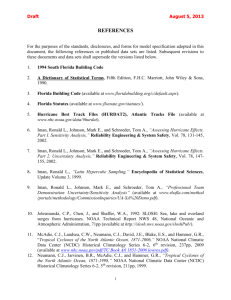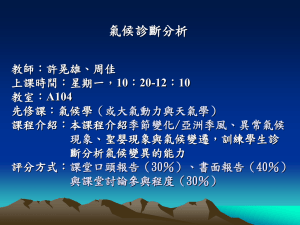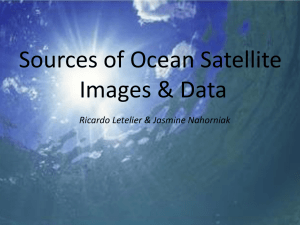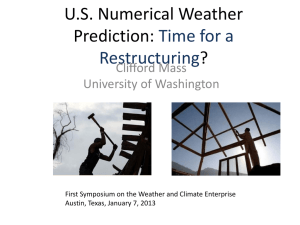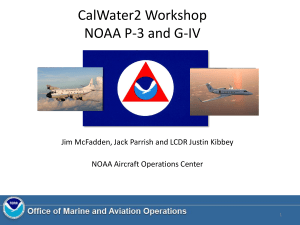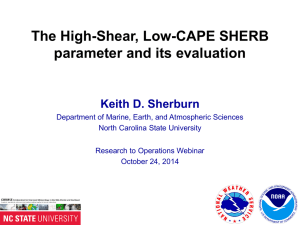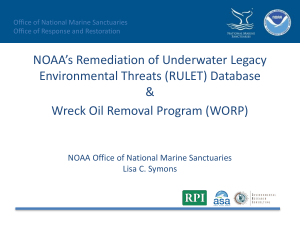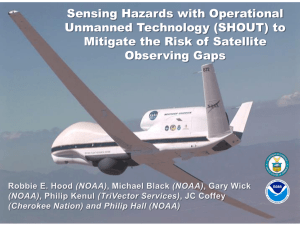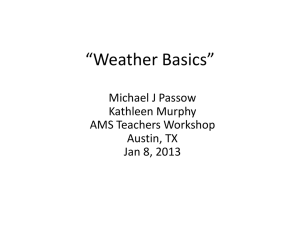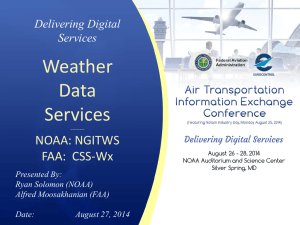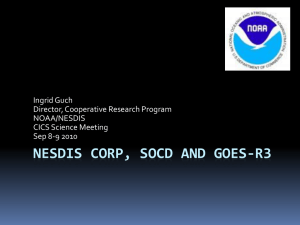Testbeds and Proving Grounds
advertisement
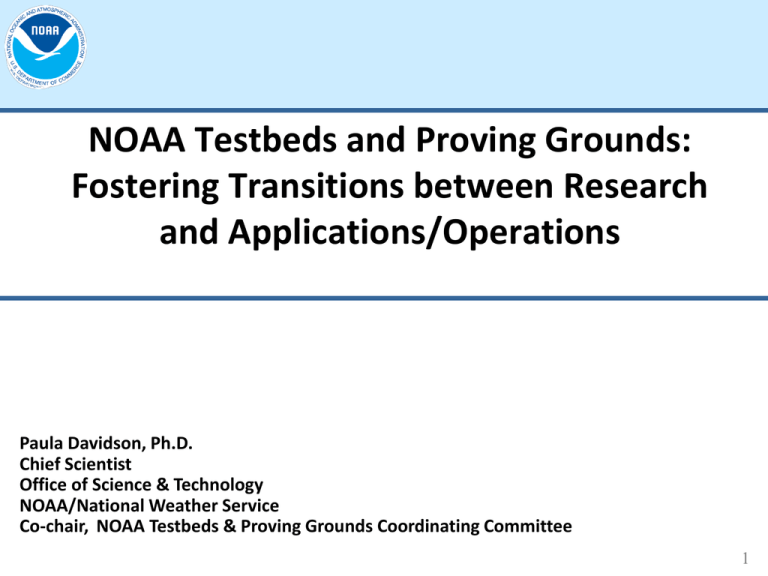
NOAA Testbeds and Proving Grounds: Fostering Transitions between Research and Applications/Operations Paula Davidson, Ph.D. Chief Scientist Office of Science & Technology NOAA/National Weather Service Co-chair, NOAA Testbeds & Proving Grounds Coordinating Committee 1 Background NOAA operates a number of testbeds (TB) and operations and services proving grounds (PG), but lacked a systematic approach for their function, mode of operation, and reporting results March 2011- NOAA Line Office Transition Managers approved guidelines and chartered a Coordinating Committee for Testbeds & Proving Grounds (TB/PG) • Guidelines: • • • • Roles and responsibilities of TB/PG Function and execution Governance Coordination: • Increasing R&D leveraging, collaboration for R2O Increasing reliance on TB/PG for advancing R2O/A/U • NOAA re-chartered COMT (2013) • CSTAR FFO links results to testing in OPG; use of NWS Virtual Laboratory (FY14) • Planning for Next Generation Global Prediction System Brief working definitions of TB/PG: TB-- for developmental testing PG-- for pre-deployment (experimental) testing R&D of advanced operations, services and science and technology capabilities 2 Current NOAA TB/PG NOAA Testbed and Proving Ground Portal AWT CTB GRPG COMT HWT JHT DTC HMT OPG http://www.testbeds.noaa.gov JCSDA SWPT (thanks to : Rich Lataitis & Barb deLuisi) 3 Framework for Transition: Phased Implementation into NWS Operations Phase Key Q Key Metric Facility Does it work? Peer-reviewed Publication TB Developmental Works with operational systems? Feasibility/ Engineering Testbed with Analysis Successful operations-like environment Experimental PG Testing Meets operational performance criteria? Go/No Go based on: Objective Performance (e.g. accuracy) Subjective Feedback Production Readiness R&D Testing Operations Universities, Government Labs, Private Industry Operational proving ground for clinical tests and full “dress rehearsal” Maintains required Objective criteria: Operations performance? accuracy and reliability 4 Coordinating Committee Comprised of TB/PG managers and LOTM-designated LO focal points: Co-chairs: Paula Davidson (NWS LO focal point) Mike Uhart (OAR LO focal point) Initial meeting (NWS and OAR members): Seattle AMS, Jan 2011 Featured Activities: Monthly virtual meetings featuring TB/PG recent tests/results Coordination/Outreach: revamped TB/PG coordination website www.testbeds.noaa.gov, coordinated SEE inputs, tutorials on guidelines, testing protocols , coordinated AOs Organize annual science-themed TB/PG workshops Adopted recommended approach to metrics for recognizing progress, Fall 2012: Relevance, quality, and effectiveness/efficiency Accomplishments and performance metrics provided in annual TBPG progress reports Summary publication (Ralph, Intrieri, et al.): The emergence of weather-focused testbeds linking research and forecasting operations. BAMS, 94, 1187-1210, 2013 5 Annual Workshops Highlight/promote integrated testing opportunities in NOAA TB/PG Overviews from current/emerging TB/PG Integrating Science Themes: 3rd Annual TBPG Workshop: Intense Precipitation Events (2012) 4rd Annual TBPG Workshop: High-impact Environmental Events (2013) 5th Annual TBPG Workshop: Advances in Environmental Prediction (2014) Best paper (Science-theme) competition Awarded to Faye Barthold (WPC, 2012); Tom Workoff (WPC, 2013); Chad Gravelle (OPG, 2014) Criteria - excellence, relevance, presentation 6 FY 2014 Activities TBPG Workshop: College Park, MD, April 16-18 Science Theme: Advances in Environmental Prediction Best Paper: Chad Gravelle, “Transitioning the GOES-R Fog and Low Stratus Products from Research To Operations Through the NWS Operations Proving Ground” Closer connection with CSTAR , MDL’s Virtual Laboratory and pilot activities: advanced testing Increasing coordination, external engagement Combined Special Testing Opportunities In-residence and virtual testing Consolidation on Website: Announcements of Opportunity 7 Thank You! Contact Information: Paula Davidson – Paula.Davidson@noaa.gov 8 Backup 9 FY13 Highlights: COMT • COMT results featured in a special issue of JGR-Oceans: 10 FY13 Highlights: DTC Hurricane-WRF (HWRF) testing for operational implementation at NCEP • HWRF provides guidance to the National Hurricane Center for the North Atlantic and Eastern North Pacific basins • Upgraded HWRF increased skill in forecasts of hurricane intensity • Regional model 27/9/3 km • HWRF has 8 components, many used in other applications • Developmental Testbed Center roles: – Support code to community – Code management – Testing and evaluation (R2O) Operational forecasts http://www.emc.ncep.noaa.gov/gc_wmb/vxt/ g 11 FY13 Highlights: GOES-R PG • NWS Central Region Fog & Low Stratus Evaluation, Aug-Dec 2012 • Products demonstrated successfully – scheduled for delivery via NWS operational systems • High latitude & Arctic testing • snow/fog, low stratus/volcanic ash, aviation applications • GOES-R Algorithm Development & Testing • Simulated satellite imagery: lightning mappers, nearcasting data, convective initiation, cloud-top cooling • Partnerships • NWS: NCEP/AWT, HWT, WPC, OPC, Regions; NESDIS : SAB; CIRA, CIMSS, NASA/SPoRT, DoD, private sector… Heritage GOES Fog Detection GOES-R Algorithm Applied to GOES GOES-R Algorithm Applied to GOES-R courtesy Mike Pavalonis, NESDIS/STAR 12 FY13 Highlights: HMT Flash Flood and Intense Rainfall Experiment (July 8-26, 2013) • 26 forecasters, researchers and model developers from WPC, NSSL, ESRL and HMT collected to examine alternatives for short term QPF and flood prediction QPE NAM- X Nest HRRR • Several operational and research models tested 12-hr mean QPF valid 2013 07/18 0Z NAM Nest NSSL WRF HRW ARW Operational forecasts http://www.emc.ncep.noaa.gov/gc_wmb/vxt/ 13 FY13 Highlights: HWT Experimental Warning Testing** • LAPS Space and Time Multiscale Analysis System (STMAS) • Forecast return moisture and instability very useful for determining if storms will change intensity in 0-2 hours • WDSSII Multiple-Radar/Multiple Sensor (MRMS) applications • • • 2-minute updates of MRMS products helps keep situational awareness high Greater efficiency in storm diagnosis Aided in positioning of storm-based warning polygons • Hail Size Discrimination Algorithm (HSDA) • • Very beneficial in breaking down areas of severe vs. non-severe hail Spatial extent of giant hail tended to be too large at times • GOES-R Algorithm Development and Testing • Simulated satellite imagery: lightning mappers, nearcasting data, convective initiation, cloudtop cooling ** additional highlights from experimental forecast testing not shown 14 FY 13 Highlights: JCSDA Improved prediction of snow depth by NOAH/GFS •U of Arizona effort, funded by NOAA’s JCSDA external research program •Collaboration with NESDIS CRTM and NWS land data assimilation teams •Improved roughness length led to increased skill in snow depth prediction by GFS/NOAH and WFR/NOAH •Implemented in GFS/NOAH land model (latest release, v 3.5). Black: observations Green: control GFS Yellow: GFS + improved roughness length Red: GFS + all improvements averaged (over 100-120degW, 50-60degN) for 3/2011 JCSDA annual report; figure courtesy of X. Zeng, U Arizona Testing new snow depth algorithms led to improved snow characterization in land-surface component (NOAH) for NCEP’s operational GFS (release v3.5) and WRF models. 15 FY 13 Highlights: JHT Uhlhorn , Hurricane Research Division: Stepped-frequency microwave radiometer bias-corrected hurricane winds Ginis/Bender, U Rhode Island/ Geophysical Fluid Dynamics Laboratory: Improved hurricane models 11 Joint Hurricane Testbed projects completed their two years of testing during the 2013 hurricane season 16 FY 13 Highlights: OPG • Virtual AWIPS proof of concept • GOES-R Fog/Low Stratus Tool • Support for AWC TB Experiment • Programming for Winter Hazard Message Simplification • Finalizing Test Plan with NASA SPoRT/GOES-R for Operational Readiness Evaluation in March 2014 • Test plan developed for Hazards Services Hydro Tool 17 FY13 Highlights: SWPT • Tested upgrades to operational Wang-Sheeley-Arge Enlil model for prediction geomagnetic storms, now implemented • Tested new coronal mass ejection analysis tool, now implemented • Tested Space Environmental Anomalies Expert System Real Time for GEO satellite operators, now implemented • Evaluated and selected magnetosphere/geospace model for transition to operations (with NASA) • Tested ionosphere and thermosphere products • Ovation Prime aurora forecast model, now implemented • Upgrade/expansion to US Total Electron Content model – N America domain ready for implementation; global product in testing 18
